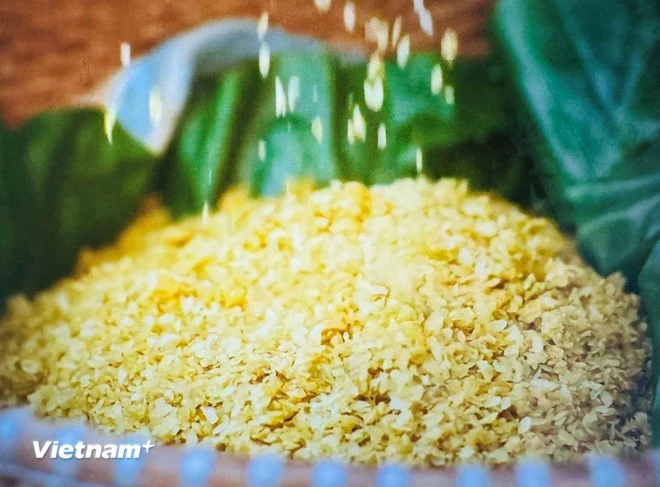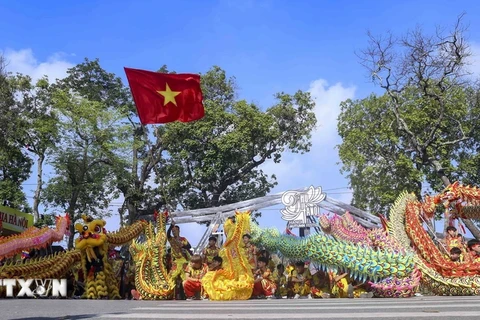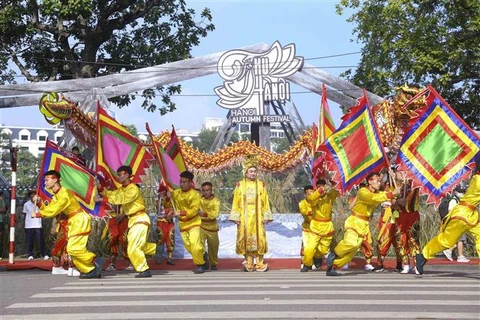
Hanoi (VNA) – Hanoi in autumn is not only marked with gentle golden sunlight, cool breezes, and the enchanting scent of hoa sua (Alstonia scholaris) but also by the distinctive delicacies that stir deep nostalgia and delight the palate.
Com (Green Young Rice)
When it comes to symbols of Hanoi's autumn, com reigns supreme. Simple and rustic, yet com is a must to try as a treat for anyone visiting the capital during this season.
As autumn arrives and the air turns cooler, it's easy to spot vendors carrying baskets of com along the streets of Hanoi. Com is the most special sweet treat among all the autumn delicacies of Hanoi. Made from young sticky rice, com has a characteristic green hue and a delicate flavor, crafted through a meticulous hand-made process.
Com is often wrapped in banana or lotus leaves and typically appears during the Mid-Autumn Festival. The sweetness of banh com (green rice cake) combined with the fragrance of the leaves delivers a unique taste that embodies the essence of Hanoi's autumn.

The most famous com comes from Vong village where locals take great pride in their specialty. Vong village's com is finely textured, and smooth and retains a light coating of rice bran, exuding the fragrance of milk-infused young rice. Enjoyed with ripe persimmons or chuoi tieu trung cuoc (a type of banana), the harmonious blend of mild and intense sweetness enhances the subtlety of this perfect pairing.
Hanoi's com is also transformed into a variety of dishes such as banh com (green rice cake), cha com (green rice pork sausage), xoi com (green flake sticky rice), che com (green rice sweet soup), com xao (stir-fried green rice), chuoi tieu cham com (banana with green rice), and com dep tron dua deo (sticky green rice mixed with coconut). Each dish offers a distinct flavor that captivates anyone who enjoys them.
Ripe Dracontomelon
As autumn sweeps across Hanoi with its cool, crisp winds, and rustling yellow leaves falling onto moss-covered rooftops of the ancient streets, the last remnants of summer’s sau (dracontomelon) begin to ripen to a golden hue.
For Hanoians, ripe sau is a beloved autumn treat. These golden, crisp fruits, with their perfect balance of sour, spicy, salty, and sweet flavors, are an irresistible snack that embodies the simplicity and allure of Hanoi's seasonal delights.

Slightly ripened sau have a greenish-yellow skin and a small, flavourful seed inside. After peeling the outer layer and cutting the fruit into a spiral, it's typically mixed with or dipped in chili salt to enhance its signature sour and crunchy taste.
A bite of this small fruit will release a burst of flavors - sour, spicy, salty, and sweet - that dance on the palate. Enjoying sau is not only a treat for the taste buds but also a delightful way to savour the unique essence of Hanoi’s autumn.
Persimmon
Crunchy persimmons are a seasonal specialty of Hanoi's late autumn. Though the outer skin may appear green, the inside reveals a vibrant orange-yellow flesh with a mild sweetness and a satisfying crunch.
When fully ripe, their outer skin turns a characteristic orange hue, making them visually appealing and refreshing on cool autumn days.
In addition to fresh fruit, soaked persimmon (hong ngam) is another autumn specialty in Hanoi. It has a short season, lasting just over a month, and becomes less common after the Mid-Autumn Festival.

Soaked persimmons are small, with greenish-yellow skin, and cannot be eaten immediately after being picked. They must be soaked in water for several days to remove the astringency and allow the fruit to soften slightly, enhancing their sweetness and crunchiness.
Unlike the red persimmons, soaked persimmons offer a unique flavour, making them a specialty of late autumn and early winter. While red persimmons are soft, sweet, and can quickly become cloying, soaked persimmons have a mild sweetness and a crisp, chewy texture that makes them enjoyable to eat in large quantities without becoming overwhelming.
Qua Thi (Gold Apple)
The thi fruit (late-season golden apple), with its rustic charm, is not only a symbol of the simple beauty of northern Vietnam's countryside but also a special sign that autumn has arrived.
In Hanoi, the thi season typically runs from September to November when it is common to see street vendors selling thi on various streets throughout the city.

There are two main types of thi fruit: one is round with a rounded base, often called thi muon, and the other is smaller, slightly flattened with a flat base, known as thi sap or thi luc sap. When ripe, the thi turns golden and can be kept for 4-5 days, while the green ones can last up to half a month when displayed.
The thi fruit gives off a gentle, rustic fragrance and is traditionally used for its scent rather than for eating. It is often purchased to be displayed on altars during the full moon and the first day of the lunar month in autumn.
Ruoi fritter (Cha ruoi)
Ruoi, a type of marine worm, is found only in brackish waters where freshwater meets the sea. This delicacy is particularly sought after during the autumn when it is at its best.

The ruoi season is brief, typically occurring from late September to early October according to the lunar calendar. Ruoi fritters, with their rich flavor of ruoi meat mixed with eggs, combined with the refreshing taste of mandarin peel, and the fragrant aroma of ginger and piper lolot leaves.
Ruoi can be prepared in various ways, such as fritters, paste, steamed, or sautéed with gac leaves. Each dish has its unique flavour and method of enjoyment, but the most popular by far is the delicious ruoi fritter./.






















